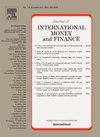Inequality, current account imbalances, and middle incomes
IF 2.8
2区 经济学
Q2 BUSINESS, FINANCE
引用次数: 0
Abstract
This paper investigates the complex relationship between current account balance and income inequality, specifically emphasizing the potential sources of nonlinearities. Based on a dataset for 52 developed and developing countries over the period 1990-2019, we first show a one-standard-deviation increase in various income-inequality indicators generates a decrease in the ratio of current account to GDP by -0.5 to -0.9 percentage points in developed countries, but has a weaker impact when the sample is expanded to include emerging and developing countries. We then show those average impacts are distorted along the distribution of economic and financial development variables. The negative impact of income inequality on current account is actually strongly conditioned to the size of financial markets and the degree of financial liberalization. For those countries displaying low GDP per capita or low levels of financial liberalization, additional income inequality seems to improve the current account balance. In addition, the decrease in the current account balance is in most cases from 1.1 to 1.9 times more important in the median country when the increase in inequality is driven by the income of top earners relative to the middle class rather than by the increase in top earners' incomes at the expense of the lowest percentiles of the distribution. These results are robust to various checks for endogeneity concerns, as well as to alternative specifications, samples, and variable definitions.
不平等、经常账户失衡和中等收入
本文研究了经常账户余额与收入不平等之间的复杂关系,特别强调了非线性的潜在来源。基于1990年至2019年期间52个发达国家和发展中国家的数据集,我们首先表明,各种收入不平等指标每增加一个标准差,发达国家的经常账户占GDP的比例就会下降-0.5至-0.9个百分点,但当样本扩大到包括新兴国家和发展中国家时,影响较弱。然后,我们表明,这些平均影响沿着经济和金融发展变量的分布是扭曲的。收入不平等对经常账户的负面影响实际上强烈地取决于金融市场的规模和金融自由化的程度。对于那些人均国内生产总值较低或金融自由化水平较低的国家,额外的收入不平等似乎可以改善经常账户余额。此外,在大多数情况下,当不平等的加剧是由高收入者相对于中产阶级的收入推动的,而不是由高收入者的收入增加以牺牲收入分配的最低百分位数为代价造成的,那么经常账户余额的减少在中位数国家的重要性从1.1倍到1.9倍不等。这些结果对于内生性问题的各种检查,以及替代规范、样本和变量定义都是稳健的。
本文章由计算机程序翻译,如有差异,请以英文原文为准。
求助全文
约1分钟内获得全文
求助全文
来源期刊

Journal of International Money and Finance
BUSINESS, FINANCE-
CiteScore
4.20
自引率
4.00%
发文量
141
期刊介绍:
Since its launch in 1982, Journal of International Money and Finance has built up a solid reputation as a high quality scholarly journal devoted to theoretical and empirical research in the fields of international monetary economics, international finance, and the rapidly developing overlap area between the two. Researchers in these areas, and financial market professionals too, pay attention to the articles that the journal publishes. Authors published in the journal are in the forefront of scholarly research on exchange rate behaviour, foreign exchange options, international capital markets, international monetary and fiscal policy, international transmission and related questions.
 求助内容:
求助内容: 应助结果提醒方式:
应助结果提醒方式:


